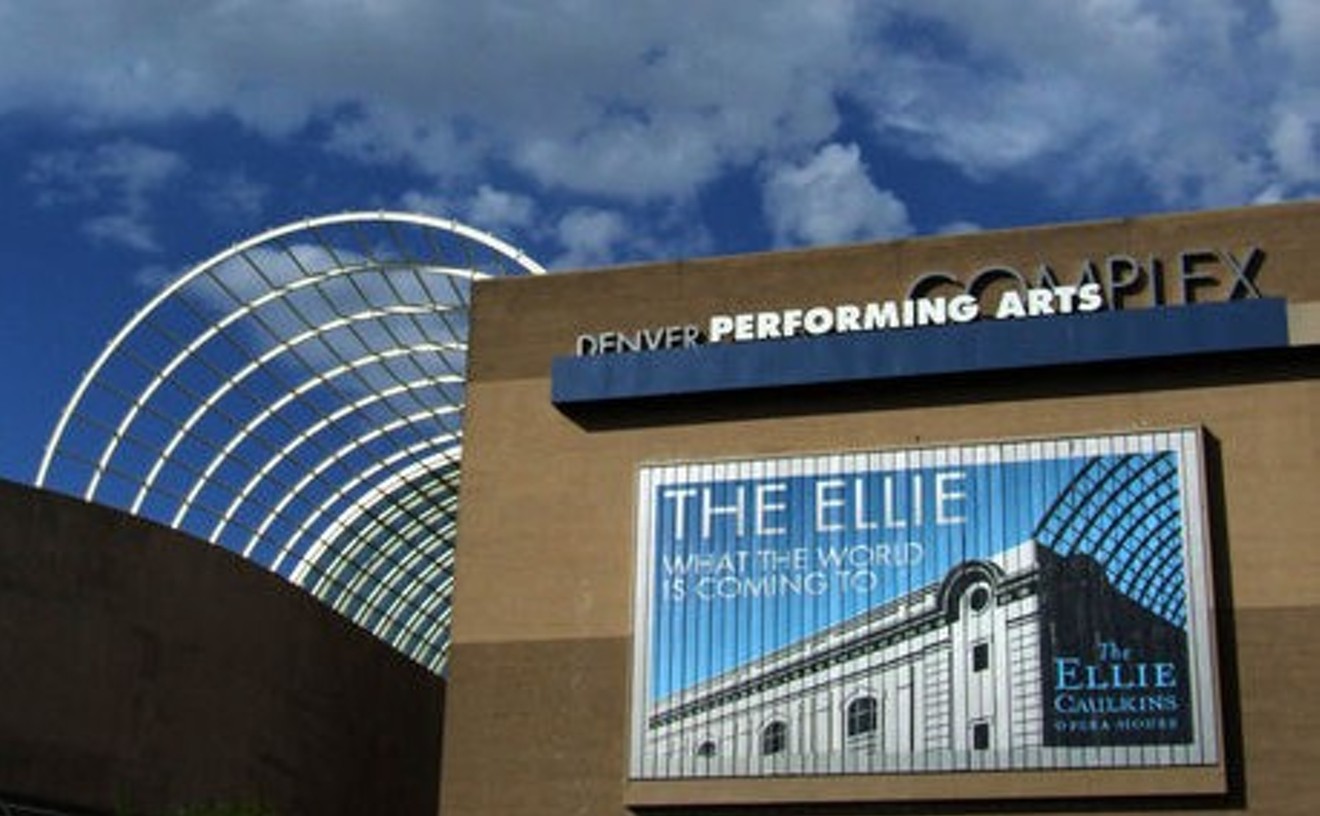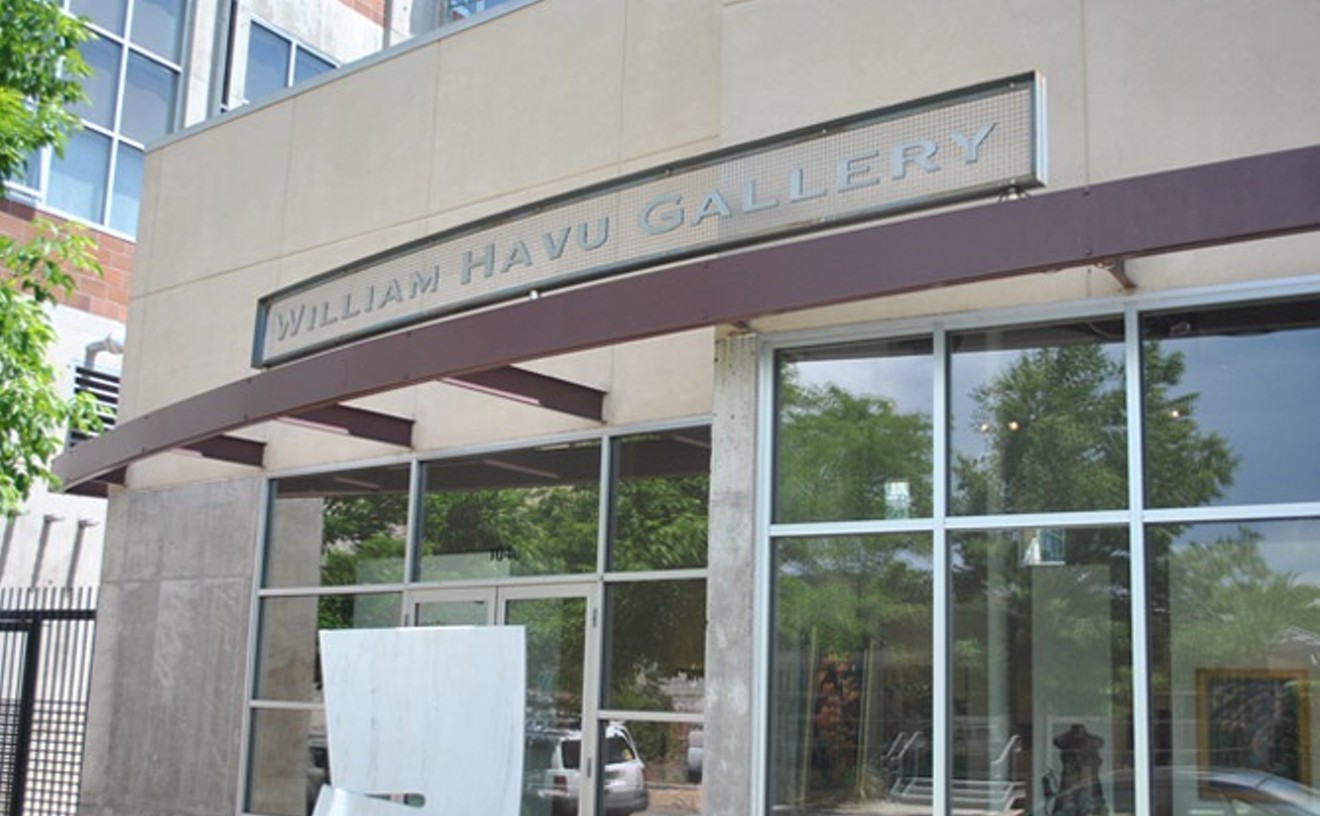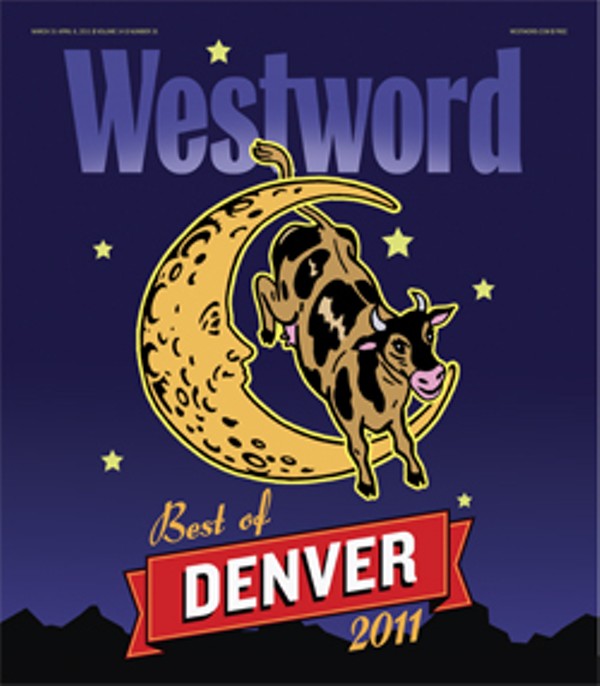Denver's Biennial of the Americas came and went last year without leaving any real mark on the community — except for the Chevy that's mounted above a reflecting pool across from the Museum of Contemporary Art Denver. The idea of having a car aiming at the ground is simple, yet "Between Life and Death" is very impressive. It was created by Gonzalo Lebrija, a Mexican artist best known for his photos and videos — until this sculpture quickly became his most significant and renowned work. Although the piece does not yet have a permanent parking spot in Denver, it could still land one, creating at least one legacy from the Biennial.
Best Theater Marketing Maven
Chris Wiger
After fifteen years as publicity director (and, briefly, head of patron relations) at the Denver Center Theatre Company, Chris Wiger left in February for a spiffy job as director of marketing and public relations at the new Lone Tree Arts Center. We started missing things about him even before he left. His extraordinary efficiency, for example: Wiger responded to requests for seats, photographs and information in record time ("Can you give me the name of that visiting actor twelve years ago who starred in ... ?"; "When did the Denver Center last do Romeo and Juliet, and who directed?"). His thoughtfulness: Get caught in a traffic jam, and you were likely to find Wiger standing in the middle of the lobby when you finally raced in, holding out your tickets; find yourself seated next to a loud drunk and he'd get you another seat, pronto. The interesting details he could pass on about each production — the concept, the costumes, the script. His regard for the actors and transparent love for the company itself: Knowing many actors don't like reading reviews while a show is running, Wiger collected albums of clippings and photographs to be distributed at the production's end. While we look forward to seeing him at Lone Tree, evenings at the Denver Center will never be the same.
Best Theater Production
Circle Mirror Transformation

Sometimes the small pleasures are the most intense. Circle Mirror Transformation followed the encounters of a group of small-town, would-be thespians learning acting and performing theater exercises — tell an anecdote, mirror another person vocally and physically, hold a conversation using only nonsense words — and slowly coming to know each other. There were no great revelations or climactic events in this Curious Theatre Company production, just occasional bright moments of insight. The interactions among director Chris Leo's excellent cast were emotionally honest and perfectly timed, and the evening was pure pleasure.
- 1080 Acoma St., Denver, 80204 Map
- 303-623-0524
- www.curioustheatre.org
Best Theater Season
Denver Center Theatre Company

After thirty years, the Denver Center Theatre Company is still going strong, with many more triumphs than stumbles in this past season. While Dracula may have been boring and Othello underwhelming, the company gave us a hilarious Hitchcock spoof, The 39 Steps, as well as The Catch, an excitingly theatrical world premiere about baseball, the farcical Reckless, and an absolutely gorgeous — beautifully designed and wonderfully acted — Midsummer Night's Dream.
- 14th and Curtis streets, Denver, 80202 Map
- 800-641-1222
- www.artscomplex.com/
Best Tiny Package
"Here an incline so known to cause defeat, next a decline thunderous and bad for knees"
There aren't enough three-inch CDs out there, but there's a logical explanation for that: Fewer and fewer people have CD players with trays in them, so it can be tough to even track down a way to play a three-inch CD. In typical Ash From Sweat style, this EP was released with lovely, hand-assembled packaging, a lyric sheet and even a spray-painted CD cover. It's hard to top the boys at Ash From Sweat when it comes to handcrafted design, and it's nice to know that even though their releases have slowed down a bit, they still have it in them to create the most original, creative packaging in town.
Best Traveling Musical
South Pacific
While the exquisite songs — "Younger Than Springtime," "Some Enchanted Evening," "Bali Hai" — continue to delight, the action in South Pacific often feels fragmented and dated. Barlett Sher's revival, which won several Tony awards, added intelligent interpretive touches and pulled everything so brilliantly together that Rodgers and Hammerstein's musical gained a new cohesion and vitality. Both musically and visually, the show was a feast. The casting was extraordinary, too, giving us a smart, quirky Nellie, a gravely dignified De Becque and an entirely original Bloody Mary.
Best Two-Part Solo
Emilio Lobato

Keeping abstraction new and different has led to the development of neo-modernism, which harks back to the mid-twentieth century but looks thoroughly modern at the same time. That's surely the case with Colorado's own Emilio Lobato, the subject of not one, but two solo shows right now. At the venerable Colorado Springs Fine Arts Center, there's Mi Linda Soledad/My Beautiful Solitude, a retrospective of Lobato's work from the early '80s to 2009, while the William Havu Gallery here in Denver is featuring Casi, Casi, showcasing work done after that. Lobato's pieces invariably refer to his roots in the San Luis Valley, typically through the use of Spanish titles and somber palettes — but the paintings themselves have an international flavor incorporating various abstract influences, notably minimalism and expressionism. And he resolves these opposites brilliantly.
- 1040 Cherokee St., Denver, 80204 Map
- 303-893-2360
- www.williamhavugallery.com
Best Unnerving Addition to Denver International Airport
Anubis

The Denver International Airport has long been a hotbed of hand-wringing conspiracy theories — the Leo Tanguma-painted mural featuring gas-masked Nazi-ghouls and multicultural children in caskets, the giant laser-eyed Mustang of Death that murdered its creator, and the Masonic capstone have all led wingnuts far and wide to speculate that our airport is in fact the future site of a New World Order-administered alien concentration camp — and given that legacy, its isn't hard to imagine that a certain tie-in to the Denver Art Museum's Tut exhibit had those hands wringing in overdrive. For two unsettling months, a thirty-foot-tall Anubis, the ancient Egyptian jackal-headed God of Death, presided like the world's least inconspicuous stalker just outside the floor-to-ceiling window of the Jeppesen terminal's security check-in, and though Anubis (along with Tut) has since moved on, the terror in our hearts is not so easily erased.
- 8500 Peña Blvd., Denver, 80249 Map
- 303-342-2000
- www.flydenver.com
Best Unofficial Biennial of the Americas Show
Perceptions

Not only were Colorado artists marginalized by the Biennial of the Americas, but so were local galleries. This situation inspired Bobbi Walker to mount an unofficial Biennial entry at her namesake gallery. Perceptions included abstract wall installations by Sabine Aell and sculptures by Kim Ferrer and John Murphy. But the tour de force was a hyperrealist installation of people around a tree made of paper by Emma Hardy, which was both staggeringly accomplished and very ambitious. Just like Walker's effort to go it alone alongside the Biennial.
- 300 W. 11th Ave., Denver, 80204 Map
- 303-355-8955
- www.walkerfineart.com
Best Update of a Longstanding Colorado Tradition
At the Edge of the World
For whatever reason — maybe because of the way the mountains stand out crisply and firmly against the sky — hard-edge abstraction has deep roots in Colorado, going back more than half a century to the work of Aspen's Herbert Bayer. Other artists in the state who have embraced the approach include Angelo de Benedetto, Otto Bach, Bev Rosen, George Woodman, Clark Richert and David Yust. And straight lines and sharp edges still have their fans, as evidenced by the work of Pard Morrison, a leader in the current generation of Colorado artists who could be called hard-edged abstractionists. At the Edge of the World, his show at Rule Gallery when it was still located on Broadway (it's relocating to RiNo this spring) represented something of a breakthrough for Morrison, with his checkerboard paintings turning into checkerboard sculptures. Based on the sumptuous works in this show, that was clearly the best move that Morrison could have made.
- 3340 Walnut St., Denver, 80205 Map
- 303-777-9473
- www.rulegallery.com





